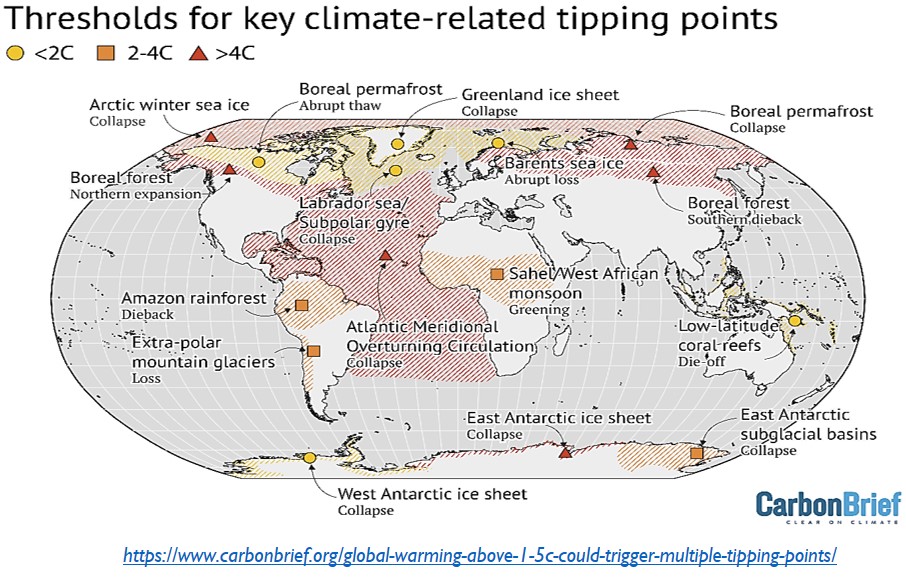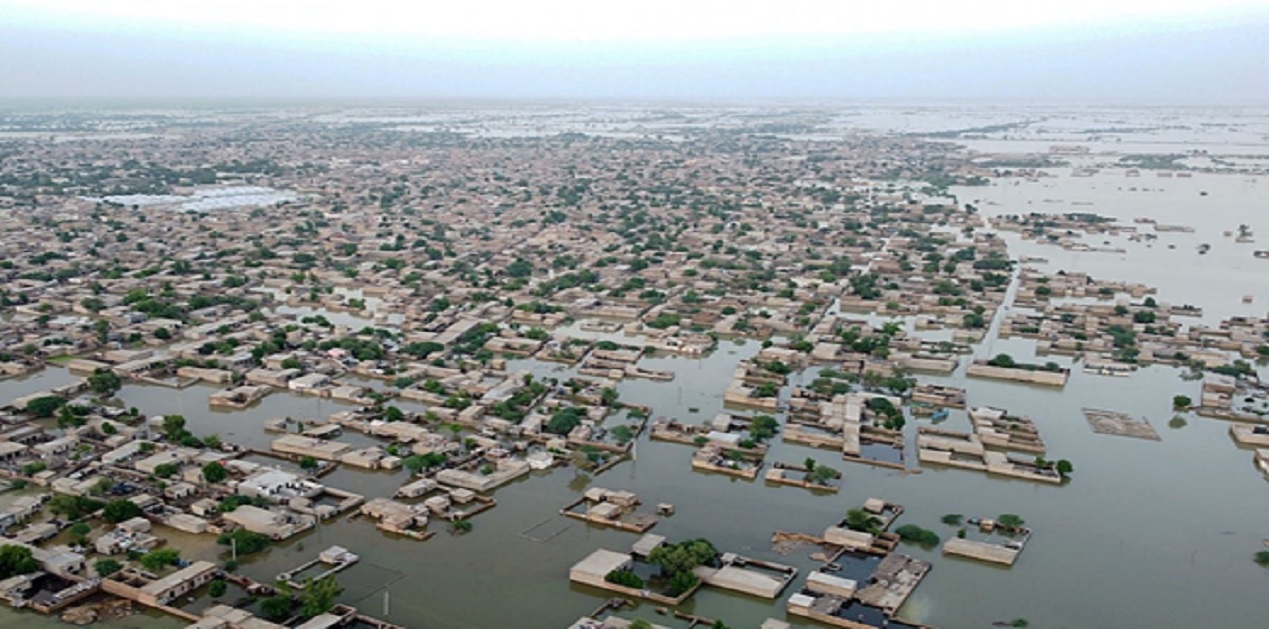Introduction
The 2022 United Nations Climate Change Conference, or COP 27, will take place at Sharm El Sheikh in Egypt from 6 to 18 November. The main aim of the conference is to spur action towards achieving the world’s collective climate goals as agreed under the Paris Agreement. The Paris Agreement, signed during COP 21 in Paris in 2015, aimed to limit the increase in global average temperature to well below 2°C and preferably to 1.5°C compared to pre-industrial levels by the end of this century. The 1.5°C target was subsequently formalised during COP 26 that was held in Glasgow, the UK in 2021as it was considered to be a safe limit, and a “planetary boundary,” beyond which the impact of climate change would intensify.[1] Countries attending the conference therefore pledged to take action to limit the increase in global average temperature to that threshold. But those pledges have turned out to be highly inadequate. In light of the tense geopolitical backdrop, it is unlikely that COP 27 will achieve its main goal of spurring greater climate action. The war in Ukraine has led to an unprecedented energy crisis and that have dealt a serious blow to the clean energy transition plans of many countries. It has also fostered animosities among key developed countries and that could derail the much needed collective action on climate change. Meanwhile, escalating tensions between the US and China over Taiwan has led to a thaw in cooperation between the two countries on the issue of climate change. The escalating geopolitical tensions however presented an opportunity for India to step up its climate diplomacy during COP 27. The country should take the lead in climate negotiations, rally developing countries, and set the agendas for global climate action.
Commitments unfulfilled
According to a recent United Nations Environmental Programme (UNEP) report, current greenhouse gas reduction pledges for action by 2030, even if delivered in full, would lead to a rise in average global temperature of about 2.5°C by the end of the century.[2] Meanwhile, if the long-term pledges by countries to hit net zero emissions by 2050 were delivered, global temperature would rise by 1.8°C. What the UNEP’s finding indicated is that the emissions reduction pledges that are made since the signing of the Paris Agreement in 2015 are not enough to limit global average temperature to 1.5°C by the end of the century. Instead, global greenhouse gas emissions continues to increase. The World Meteorological Organization (WMO) reported recently that all the main greenhouse gases hit record highs in 2021, with an alarming surge in emissions of methane, a potent greenhouse gas. CO2 concentrations in 2021 were 415.7 parts per million (ppm), methane at 1,908 parts per billion (ppb), and nitrous oxide at 334.5 ppb.[3] These values constituted 149 per cent, 262 per cent, and 124 per cent of pre-industrial levels respectively. As a result, the 1.5°C target is now perilously close to being breached. In fact, scientists have estimated that the probability of one of the next five years surpassing 1.5°C is now 50 per cent.[4]
Average global temperature has already reached 1.2°C above pre-industrial levels. This level of warming is in line with model projections and is therefore not completely unanticipated. What is unanticipated is the sheer severity and frequency of extreme weather events that has occurred as a result of the increase in average global temperature. For example, this year alone, record heatwaves and wildfires has swept the US and Europe, punishingly high temperatures scorched India and China, and ruinous flooding affected the US, Pakistan, and Africa. Pakistan offers an interesting case study of just how vulnerable and unprepared developing countries are to the ravages of extreme weather events. Between June and August this year, torrential rains and a combination of riverine, urban, and flash flooding led to an unprecedented disaster in the country. As of 11 October, 94 districts, more than half of all districts in the country (most of them located in the provinces of Baluchistan, Sindh, and Khyber Pakhtunkhwa), were declared as “calamity hit.” In all, around 33 million people, or one in seven Pakistanis, have been affected by the floods, including nearly 8 million displaced. The floods have taken the lives of more than 1,700 people. The flood could lead to a rise in Pakistan’s poverty rate by 3.7 to 4.0 percentage points and push between 8.4 and 9.1 million people into poverty. Estimates indicated that the flood has caused more than USD 14.9 billion in damages and USD 15.2 billion in economic losses.[5] Meanwhile, around USD 16.3 billion would be needed for rehabilitation and reconstruction. While this disaster is unfortunate, the projected increase in average global temperature by 2.5°C under current emission reduction pledges would deliver death and destruction far greater than already suffered.
Getting closer to “tipping points”
Worse still, a wave of secondary calamities are now very close to being triggered due to rising temperatures. Experts have warned that there is a “significant likelihood” of multiple “tipping points” being crossed if global temperatures exceed 1.5°C.[6] A tipping point is when a temperature threshold is passed, leading to unstoppable change in a climate system, even if global warming ends. The tipping points would take effect on timescales varying from a few years to centuries and passing one tipping point is often likely to help trigger others, producing cascades.
A recent study, published in the journal Science, reviewed hundreds of academic studies to provide an “updated assessment” of climate-related tipping points. The study identified 16 tipping “elements” in total and outlined the temperature thresholds, timescales, and impacts of each. These tipping elements are: Arctic winter sea ice collapse, Boreal forest northern expansion, Amazon rainforest dieback, Extra-polar mountain glaciers loss, West Antarctic ice sheet collapse, Boreal permafrost abrupt thaw, Labrador Sea/Subpolar gyre collapse, Atlantic Meridional Overturning Circulation collapse, East Antarctic ice sheet collapse, Greenland ice sheet collapse, Barents Sea ice abrupt loss, Sahel/West African monsoon greening, Boreal permafrost collapse, Boreal forest southern dieback, Low altitude coral reefs die-off, and East Antarctic subglacial basins collapse. The authors of the study find that five tipping elements – including the collapse of the West Antarctic ice sheet and abrupt permafrost thaw – are already within reach. If temperatures rise to 1.5°C, four climate tipping elements will become “likely” and a further six will be “possible”. Meanwhile, 13 tipping elements will be either “likely” or “possible” if the planet warms by 2.6°C, as expected under current climate policies.

What hope for COP 27?
In light of the observed changes in global climate system and the increasingly dire warnings about the future, the task facing delegates at COP 27 has never been greater. The main aim of the climate summit is to spur action towards achieving the world’s collective climate goals as agreed under the Paris Agreement in 2015. As has already been noted, current greenhouse gas reduction pledges for action by 2030 remains insufficient and even if they are implemented in full, it will still lead to a rise in global average temperature of about 2.5°C by the end of the century. However, the climate summit is unlikely to yield more ambitious greenhouse gas reduction pledges and actions. As such, the 1.5°C target of the Paris Agreement is likely to be surpassed this decade. At the same time, there are growing calls for rich, high-emitting countries to compensate developing ones so that they can put in place infrastructure and other measures to reduce the worst impacts of climate change. In other words, loss and damage finance for countries experiencing the worst consequences of climate change will be a key and contentious issue at COP 27. Following a devastating flood, Pakistan has emerged as a vocal proponent of loss and damage finance. Pakistani commentators argued that the country contributed less than 1 per cent of global carbon dioxide emissions but it bear the brunt of climate change triggered by rich countries’ emissions. One commentator went as far as to suggest that rich countries “caused the recent catastrophic flooding” and they should pay up for the damages incurred.[7] Rich countries however have rejected such claims, fearing unlimited liabilities. They did promised to provide USD 100 billion per year by 2020 for climate action in developing countries during COP 15 in Copenhagen in 2009. That promise however has not been realized.
Current geopolitical tensions is likely to cast a long shadow on what could potentially be a lackluster, if not disastrous, COP 27. It has already taken its toll on climate change cooperation just when collective action at the global level is needed more than ever. For example, the war in Ukraine has contributed to the largest energy shock in decades, driving up oil and gas prices and reshaping the global energy system. That could have both positive and negative consequences. On the one hand, concerns about energy security in the wake of the war has led a number of European countries to accelerate their transition towards cleaner energy. That could prove beneficial in the long run. On the other hand, the war in Ukraine also gave a boost to coal-fired power across Europe. That could drastically increase carbon emissions in the short-term. Besides, the war in Ukraine has fractured relationships between the US and Russia and between Europe and Russia and that could imperil collective action on climate change at the global level. Tensions have also increased between China and the US over Taiwan. Following a visit to the country by US House Speaker Nancy Pelosi in August, China has suspended climate talks with the US. The move marks a setback to intensified dialogue on climate change between the world’s two biggest emitters. The US and china together are responsible for about 40 per cent of the world’s greenhouse gas emissions and a breakdown in cooperation between them could spell disaster for global efforts to combat climate change and for COP 27.
An opportunity for India’s climate diplomacy
Escalating geopolitical tensions presented an opportunity for India to step up its climate diplomacy. Although India has contributed only around four per cent of global cumulative emissions from 1850 to 2019, it has taken its fair share of responsibility in addressing climate change.[8] This is evident in the country’s commitments to have 50 per cent of power generated by renewable energy by 2030; increase non-fossil energy capacity to 500 GW by 2030; reduce the projected carbon emissions by 1 billion tonnes by 2030; reduce the carbon intensity of its economy by 45 per cent by 2030; and reach net zero emissions by 2070.[9] India was also instrumental in establishing the International Solar Alliance (ISA), an alliance of over 100 signatory countries that aim to harness solar power, and the Coalition for Disaster Resilient Infrastructure (CDRI), a partnership of national governments, UN agencies and programmes, multilateral development banks, etc. that aim to promote the resilience of new and existing infrastructure systems to climate and disaster risks. India has also launched the “Lifestyle for the Environment - LiFE Movement” in June this year to promote a lifestyle “that is in tune with our planet and does not harm it.”[10] Given these initiatives, India is well-placed to take the lead in setting the agendas for global climate action during COP 27.
India should in particular reiterate the principles of equity and Common But Differentiated Responsibilities and Respective Capabilities (CBDR-RC) vehemently. CBDR-RC acknowledge the different capabilities and differing responsibilities of individual countries in addressing climate change. India always believed that while climate change is a universal problem that all countries have an obligation to address, developed countries should take a bigger share of the burden as they have historically emitted most of the planet-warming greenhouse gases. As such, it should exert greater pressure upon developed countries and China to do more as they are the source of most past and current greenhouse gas emissions.
India should also call for equitable access to the global carbon budget and claim its fair share of it vehemently. Carbon budget is the maximum amount of carbon dioxide that can be emitted while still having a chance to limit global warming to 1.5°C or 2°C. The Intergovernmental Panel on Climate Change (IPCC) observed that the world can emit only about 500 gigatonnes of carbon dioxide (GtCO2) starting 1 January 2020 for a 50 per cent chance of limiting global warming to 1.5°C.[11] Already, 86 per cent of the carbon budget has already been used and the remaining budget will exhaust in the next 10 years or so. Developed countries as well as China have reportedly used a disproportionate share of the carbon budget while developing countries are left with negligible carbon space. India on the other hand have used far less than its fair share of the carbon budget as it contributed only around four per cent of global cumulative emissions. Thus, its emissions can continue to grow. India should also continue to lend its weight on the issue of climate finance including for loss and damage during COP 27 as it is among the most vulnerable countries in the world to climate change. Also, given that India has set for itself highly ambitious commitments including 50 per cent of power generated by renewable energy by 2030 and achieve net zero emissions by 2070, it needed all the help that it can get from developed countries in terms of finance and technology transfer.
Endnotes :
[1]Harvey, Fiona. “Ratchets, phase-downs and a fragile agreement: how Cop26 played out.” The Guardian. November 15, 2021. https://www.theguardian.com/environment/2021/nov/15/ratchets-phase-downs-and-a-fragile-agreement-how-cop26-played-out
[2] “Emissions Gap Report 2022: The Closing Window - Climate crisis calls for rapid transformation of societies.” Nairobi. https://www.unep.org/resources/emissions-gap-report-2022
[3]World Meteorological Organization (WMO). 2022. “WMO records biggest increase in methane concentrations since start of measurements.” Press Release. Number 26102022. October 26. https://public.wmo.int/en/media/press-release/more-bad-news-planet-greenhouse-gas-levels-hit-new-highs#:~:text=WMO's%20Greenhouse%20Gas%20Bulletin%20reported,biological%20and%20human%2Dinduced%20processes.
[4]World Meteorological Organization (WMO). 2022. “WMO update: 50:50 chance of global temperature temporarily reaching 1.5°C threshold in next five years.” Press Release. Number: 09052022. May 9. https://public.wmo.int/en/media/press-release/wmo-update-5050-chance-of-global-temperature-temporarily-reaching-15%C2%B0c-threshold
[5]The Government of Pakistan, Asian Development Bank (ADB), European Union, United Nations Development Programme (UNDP), World Bank, and United Nations Environment Programme (UNEP). 2022. “Pakistan Floods 2022: Post-Disaster Needs Assessment.” Main Report. October. https://reliefweb.int/report/pakistan/pakistan-floods-2022-post-disaster-needs-assessment
[6]McKay, David I. Armstrong et al. 2022. “Exceeding 1.5°C global warming could trigger multiple climate tipping points.” Science. Vol. 377. Issue 6611. September 9. https://davidarmstrongmckay.files.wordpress.com/2022/09/armstrong-mckay-et-al-2022_climate-tipping-points-reassessment_accepted-version-with-figures.pdf
[7]Khokhar, Mustafa Nawaz. “Rich countries caused Pakistan’s catastrophic flooding. Their response? Inertia and apathy.” The Guardian. September 5, 2022. https://www.theguardian.com/commentisfree/2022/sep/05/rich-countries-pakistan-flooding-climate-crisis-cop27
[8] “India used far less than its share of global carbon budget, emissions can grow: Govt.” Economic Times. July 30, 2022. https://economictimes.indiatimes.com/news/india/india-used-far-less-than-its-share-of-global-carbon-budget-emissions-can-grow-govt/articleshow/93226234.cms
[9] “India's Stand at COP-26.” Ministry of Environment, Forest and Climate Change (MoEFCC). February 3, 2022. https://pib.gov.in/PressReleasePage.aspx?PRID=1795071
[10] “PM launches global initiative ‘Lifestyle for the Environment- LiFE Movement’.” PMIndia. June 5, 2022. https://www.pmindia.gov.in/en/news_updates/pm-launches-global-initiative-lifestyle-for-the-environment-life-movement/
[11]Intergovernmental Panel on Climate Change (IPCC). 2021. Climate Change 2021: The Physical Science Basis. Working Group I Contribution to the Sixth Assessment Report of the Intergovernmental Panel on Climate Change. [Masson-Delmotte, V., P. Zhai, A. Pirani, S.L. Connors, C. Péan, S. Berger, N. Caud, Y. Chen, L. Goldfarb, M.I. Gomis, M. Huang, K. Leitzell, E. Lonnoy, J.B.R. Matthews, T.K. Maycock, T. Waterfield, O. Yelekçi, R. Yu, and B. Zhou (eds.)]. Cambridge University Press, Cambridge, United Kingdom and New York, NY, USA, 2391 pp. https://report.ipcc.ch/ar6/wg1/IPCC_AR6_WGI_FullReport.pdf
(The paper is the author’s individual scholastic articulation. The author certifies that the article/paper is original in content, unpublished and it has not been submitted for publication/web upload elsewhere, and that the facts and figures quoted are duly referenced, as needed, and are believed to be correct). (The paper does not necessarily represent the organisational stance... More >>
Image Source: https://www.stylist.co.uk/news/pakistan-floods-how-to-help/703784












Post new comment